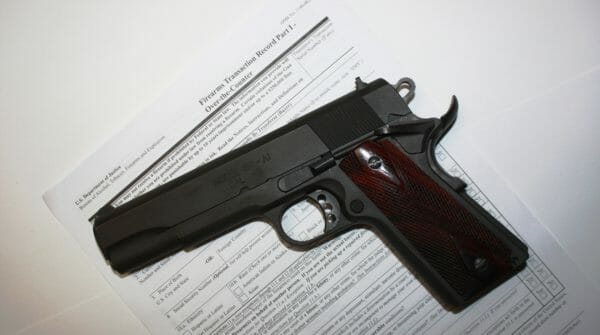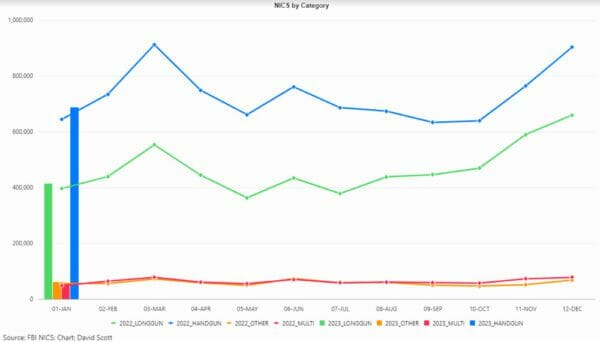
The National Instant background Check System (NICS) gun sales and background checks are slightly higher for January of 2023 than they were for January of 2022. Gun sales are six percent higher, and background checks are three percent higher than in January of 2022. Background checks continue to outnumber gun sales by over 2-1, as many background checks are done for purposes other than a gun sale.
With about 1.22 million guns sold in the NICS system in January, the United States is on track to equal the number of guns sold in 2022, about 17 million. If the trend continues, as seems likely, the estimated number of privately owned firearms in the United States will reach the half-billion mark, over 500 million, in September of 2023.
Corrected for constant dollars, firearms prices are at historically low levels. Prices of quality firearms were only lower when there were millions of military surplus firearms on the market. Two examples are given below.

In 1963, M1 carbines were sold off at $17.50, with $2.50 shipping. $20 in today’s dollars would be $194. A good SKS could be had for $100 in 1994, and ammunition was absurdly cheap. $100 in 1994 dollars would be $200 in today’s dollars. Those examples are extremes. The rifles were military surplus, sold well below the market costs of production of a similar firearm.
Today, a person can purchase a new variant of the AR15 for as little as $300 if one is willing to buy a complete lower receiver and a complete upper receiver separately and take the one minute required to connect the two. The act of connecting the two assemblies probably removes manufacturers’ liabilities, as they only sold part of a firearm. A reduction in liabilities reduces the cost.
To place the $300 figure in perspective, the AR15 sold to ordinary citizens in 1965 at $189.50, or $1,785 in today’s dollars. It was a Colt, name-branded product, but the service life is likely the same as a current generic AR15-style rifle.
Today’s firearms are approaching the relative price asked for bargain basement military surplus firearms brought when they were placed in the US market. If an adult wants a firearm and ammunition today, they are easily available for less than a week’s work at minimum wage (at least $290 before taxes). Many jobs are going begging, driving up wages. As a practical matter, anyone who wants to work can find a job.
A perfectly serviceable .22 rifle can be purchased for about $100 if you shop a bit. A serviceable .22 semi-automatic handgun can be had for $200. Serviceable 9mm handguns can be had for $250.
Modern materials and manufacturing techniques have made practical, reliable firearms affordable for more and more people.
Even if a person opts to purchase a fully assembled AR15, the cost is as low as $500. For a person on a minimum wage of $7.25 per hour, the cost is 70 hours of labor. In 1965, the minimum wage was $1.25 per hour. A Colt AR15 would have cost 151 hours of minimum wage labor.
Gun sales appear to have arrived at a new normal of about 1.5 million monthly sales, or 18 million a year. These new sales can be attributed to the normalization of domestic and international uncertainty. Some of it is the reduction of firearm costs compared to wages.
About Dean Weingarten:
Dean Weingarten has been a peace officer, a military officer, was on the University of Wisconsin Pistol Team for four years, and was first certified to teach firearms safety in 1973. He taught the Arizona concealed carry course for fifteen years until the goal of Constitutional Carry was attained. He has degrees in meteorology and mining engineering, and retired from the Department of Defense after a 30 year career in Army Research, Development, Testing, and Evaluation.

from https://ift.tt/JUpZzYj
via IFTTT

No comments:
Post a Comment